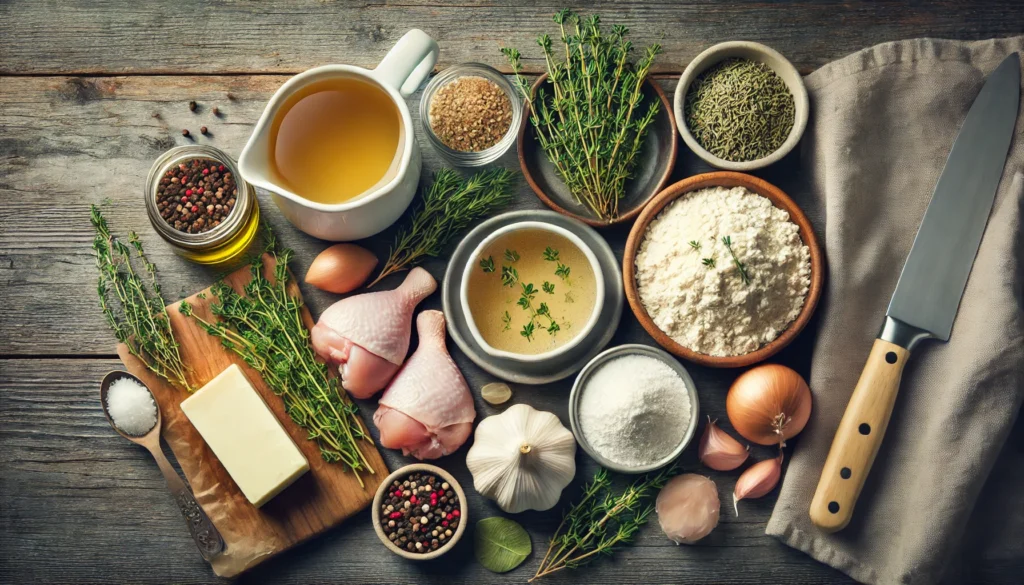Chicken gravy is a classic comfort food that enhances the flavors of various dishes, from mashed potatoes to roasted chicken. But what exactly are the ingredients in chicken gravy? This article breaks down the essential components and techniques to help you make the perfect gravy every time.

Introduction to Chicken Gravy
Chicken gravy is a savory sauce traditionally made from the drippings of a roasted chicken, combined with a few key ingredients to create a thick, flavorful topping. It’s a staple in many cuisines, adding depth and richness to meals. To understand the versatility of chicken gravy, it’s important to grasp the basic components and their roles.
For those looking to make the most out of their chicken dishes, understanding the components of gravy can elevate a meal from ordinary to extraordinary. For a more comprehensive understanding of how gravy fits into various chicken dishes, explore Easy Homemade Chicken and Gravy Recipe: Comfort Food Made Simple.
Essential Components of Chicken Gravy
- Chicken Drippings and Broth
The base of most gravies is either the chicken drippings collected from roasting or a high-quality chicken broth. Drippings add a rich, deep flavor that is hard to replicate, while broth offers a lighter, more consistent base. For those who want to enhance the flavor without drippings, using a rich broth or stock can be an excellent alternative. You might find the tips in How Can I Make Chicken Gravy Taste Better? quite helpful. - Thickening Agents: Flour vs. Cornstarch
To achieve the desired thickness, flour and cornstarch are the most common thickening agents. Flour, when cooked with fat, creates a roux that thickens the gravy as it simmers. Cornstarch, mixed with a bit of water, acts as a quick thickener without needing to be cooked as long. Each thickener offers different textures and slight flavor variations. - Fats: Butter, Oil, and Other Options
The type of fat used in chicken gravy can alter both its flavor and texture. Common choices include butter, which adds a rich, creamy taste, and chicken fat from the drippings, which provides a deeper chicken flavor. For a healthier option, consider using a light olive oil. - Seasonings and Aromatics for Flavor Enhancement
Basic seasonings like salt, pepper, garlic powder, and onion powder are essential for flavoring chicken gravy. Adding fresh aromatics such as chopped onions, garlic, celery, and herbs can enhance the taste, giving the gravy a homemade, robust flavor. For more tips on seasoning, you can refer to What is the Secret to Good Gravy?.
Different Types of Chicken Gravy
- Classic Gravy Using Chicken Drippings
Start by collecting the chicken drippings and fat from a roasted chicken. Combine with a roux made of flour and butter, then slowly whisk in chicken broth until the desired consistency is reached. Season with salt, pepper, and herbs. - Gravy Without Drippings
For those without drippings, chicken broth can be used to create a delicious gravy. Start with a fat (like butter or oil), make a roux with flour, and slowly whisk in the broth. Adjust the seasoning to taste. - Creamy Chicken Gravy Variations
To make a creamier version, add a splash of heavy cream or milk to the gravy. This method provides a richer texture and a slightly milder flavor, balancing the savory notes from the drippings or broth.
Tips for Making Perfect Chicken Gravy
- Avoiding Lumps in Your Gravy
To avoid lumps, always whisk continuously while adding the liquid to the roux. If lumps do form, use a fine mesh strainer to remove them or a blender to smooth the gravy out. - How to Adjust Gravy Consistency
If your gravy is too thick, slowly add more broth until you achieve the desired consistency. If too thin, mix a small amount of flour or cornstarch with water to create a slurry and gradually add it to the gravy, simmering until it thickens.
FAQs About Chicken Gravy Ingredients and Preparation
- What is the secret to good gravy?
The key is in the balance of flavors and the proper thickening technique. Using quality ingredients and the right proportions ensures a delicious gravy. - Can you make gravy ahead of time?
Yes, gravy can be made ahead and reheated gently on the stove. If it thickens too much upon cooling, thin it with a bit more broth or water. - How do you store and reheat chicken gravy?
Store leftover gravy in an airtight container in the refrigerator for up to three days. Reheat on the stove over low heat, stirring occasionally. - What can be used instead of chicken drippings?
High-quality chicken broth or stock can replace drippings, providing a similar base for the gravy without the need for roasting a chicken. - Is there a gluten-free option for making chicken gravy?
Yes, use cornstarch or a gluten-free flour blend to thicken the gravy instead of regular flour.
Health Considerations and Alternatives for Chicken Gravy
For those looking to reduce sodium or fat, opt for low-sodium broth and use less butter or a healthier oil alternative. A gluten-free option can easily be made by substituting cornstarch or another gluten-free thickener. If you are looking for a vegan version, replace the chicken broth with a rich vegetable broth and use plant-based butter or oil.
Conclusion
Making chicken gravy from scratch is a straightforward process that can be tailored to suit various dietary needs and flavor preferences. Whether using traditional drippings or a broth-based recipe, understanding the role of each ingredient will help you create a delicious gravy every time. Experiment with different variations to find your favorite!
